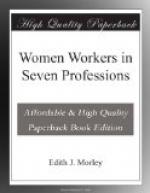This is not a paper to discuss the suitability of women for midwifery. All through the ages it has been done by women, until early in the nineteenth century in England and its colonies, it gradually became customary for men-doctors to attend such cases; apart from this, the work of midwifery has never been in the hands of men, except when abnormal cases have required the assistance of a doctor with knowledge of anatomy and skilled in instrumental delivery. Even before the passing of the Midwives Act in 1902, statistics proved that three-quarters of all confinements in this country were attended by women.
Continental countries have been alive to the need for training the women who did this work. For instance, in the great General Hospital in Vienna with its 3,000 beds, 550 beds were kept apart for maternity wards, and of these, 200 were reserved for the State training of midwives—a course of one year’s duration being obligatory, with daily lectures on every detail in midwifery from the Professor of Obstetrics. The present writer attended these lectures daily for six months in 1885, and was made to feel the importance in teaching of “hammering” at essentials and of questioning, so that the lecturer might discover whether he were talking above the head of the least clever of the audience.
England’s population increased so steadily and rapidly during the nineteenth century, that it seemed to trouble no one that countless lives of mothers and babies were lost during the perils of child-birth; it remained the only civilised country of Europe where a woman could practise as a midwife without any training at all.
For nearly twenty years before the passing of the Midwives Act in 1902, a small band of devoted women laboured in season and out of season urging on Parliament the need of a bill requiring a minimum of three months’ theoretical and practical training and an examination before trusting a woman with the lives of mother and child.
This historical fact alone is a sufficiently cogent reason for the now ever-increasing demand on the part of women for the parliamentary vote.
The Central Midwives Board (C.M.B.), a body of eight members (experts elected by various bodies, such as the Royal Colleges of Physicians and Surgeons, the British Nurses’ Association, the Midwives’ Institute, etc.), now exercises supervision over the midwives of the whole of England and Wales, though local supervising authorities also take cognisance of midwives’ work and investigate cases of malpractice and the like. The address of the Central Midwives’ Board is Caxton House, Westminster.




